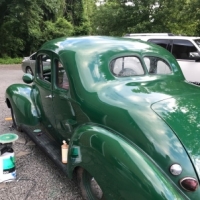Door Latch Adjustment
OK, so the Wasp I bought in 1973 needed to have the doors slammed to make them latch, but I only paid $100 for it.:) Now, I have a 1949 Commodore that cost considerably more, but the doors still need slamming.:mad:
SO, if I loosen the strike plate, the door rattles. My question is:
Is there a wear point in the door latch mechanism that can be smoothed or built up that will make the latch work properly? or are there other ways to make the door work like new.
SO, if I loosen the strike plate, the door rattles. My question is:
Is there a wear point in the door latch mechanism that can be smoothed or built up that will make the latch work properly? or are there other ways to make the door work like new.
0
Comments
-
Also, new rubber will cause you to have to slam the doors. I put all new rubber on my '51 and have to slam the doors in order to get them closed. Most of this seems to come from the seal that is in the front next to the vent window. Do indeed be careful when adjusting the door striker plate and ensure that it is closing on the second latch, not the first.0
-
The strikers would be the #1 place to start, followed by checking your door seals...an old body shop trick is to take a piece of notebook paper and shut it in the door frame and seal and it should hold when you tug on it - but not be too tight.
The last 2 things I'd check would be the door hinges/pins - if there is slop there - that will affect the adjustment - then lastly, look to see if your door sags when opening.
If the hinges/pins are good this would indicate some broken spot welds where the hinges bolt to the inner door frame - or even splits in the sheet metal around the hinge pocket.0 -
The striker plate might be positioned too far in. If you haven't tried this, move the plate outward to see if this allows the door to close properly.0
-
I believe the new striker plates available from K-gap do the trick, as the profile is better on the inside surface, moving the pinback further so it latches. I built the strikers up on the inside surface on my '53 Hornet, and the doors just click shut, but don't attempt this unless you are skilled at brazing die-cast, otherwise they will collapse into a heap of mush! A similar problem occurs with the star-wheel '54 door closers as on the Jet, where the inside tooth surface of the striker plate wears, and the star-wheel can't engage tightly. I have made up new bronze strikers for these, and they work wonderfully.
Geoff.0 -
Right about the new rubber into the doors. The new "S" weatherstrip is a air foam mold that just doesnt give enough and has too much rebound. Check to see if you have resistance in th edoor about 1-2 inches before the latch.0
-
-
HudMotCarCo wrote:The striker plate might be positioned too far in. If you haven't tried this, move the plate outward to see if this allows the door to close properly.
This is usually what needs done. Also make sure that the latch is oiled good,and all the screws are tight in the door latch and the striker plate.0 -
Thanks for all the good advice. If I adjust the striker out, the door stands proud of the rest of the body by about 3/16". It seems that the slot in the striker is worn and allows too much movement. I was thinking about brazing up the slot clearance, but I see that K-Gap has the strikers at a fair price so I'll probably buy some new ones.0
This discussion has been closed.
Categories
- 36.9K All Categories
- 113 Hudson 1916 - 1929
- 20 Upcoming Events
- 92 Essex Super 6
- 28.6K HUDSON
- 574 "How To" - Skills, mechanical and other wise
- 995 Street Rods
- 151 American Motors
- 178 The Flathead Forum
- 49 Manuals, etc,.
- 78 Hudson 8
- 44 FORUM - Instructions and Tips on using the forum
- 2.8K CLASSIFIEDS
- 608 Vehicles
- 2.2K Parts & Pieces
- 77 Literature & Memorabilia
- Hudson 1916 - 1929 Yahoo Groups Archived Photos



